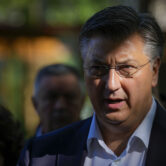BERLIN, Germany (AFP) — Berlin is a city with two of everything, thanks to the rival sides competing during the Cold War to delight citizens with zoos, television towers or football teams.
"The two sides tried to best each other by showing off their ability to rebuild Berlin as well and as quickly as possible" after 1945, said Hanno Hochmuth, a researcher at Potsdam's Centre for Contemporary History.
Here are some top examples of the German capital's double vision.
Biggest zoo versus richest
The biggest zoo in all of Europe is tucked away in the sleepy Friedrichsfelde residential district of former East Berlin.
Known as the Tierpark, the attraction built by the communist government in 1955 is less well-known and less wealthy than the Zoologischer Garten in the West, which dates back to 1844.
At its height, the socialist zoo boasted 120 different species, with many originating from other countries across the eastern bloc.
Since reunification in 1990, the former competitors have tried to cooperate as closely as possible.
Twin TV towers...
By contrast, the Fernsehturm (TV tower) completed in 1969 at East Berlin hub Alexanderplatz has become a tourist icon of the city, comparable to landmarks like Paris' Eiffel Tower.
But the Cold War context meant its construction was inevitably a propaganda coup.
"The Soviet bloc wanted to show off its great progress in as many ways as possible. It's no accident that the TV tower's shape apes that of a satellite like Sputnik," the Soviet Union's first, pointed out researcher Hochmuth.
While the antenna soaring 1207 feet above the pavement still broadcasts, its little sister deep in Berlin's West, the Berliner Funkturm, has abandoned its original function.
Like the communist version, though, the steel tower hosts one of the city's highest restaurants 150 yards up in the air.
...and opera triplets
In 1961, West Berlin finished restoration of its only opera house, the Deutsche Oper, partially destroyed during WW2.
The only stage for the art form in the free side of the capital, it became one of West Germany's most important cultural venues.
But since reunification, it has cooperated with its Eastern counterparts, the Staatsoper Unter den Linden and the Comic Opera, a few hundred yards apart on the famous central Berlin boulevard.
Airports: painful reunion
In 1945, strategic sites like airports lay in ruins after years of bombardment.
Schoenefeld airport in the East provided the Soviets with serviceable runways.
But when the eastern bloc launched its blockade of the capital's western half, from 1948-9, German workers together with American and French allies managed to throw together Tegel airport in the northwest in just 90 days.
It supported the Airlift operation that kept the city supplied with food and other essentials throughout the lockdown, complementing pre-war Tempelhof in the south.
Closed in 2008, Tempelhof has become a public park.
But Tegel and Schoenefeld are both still in operation -- long after they were supposed to have been replaced by the new Berlin-Brandenburg Willy Brandt airport, slated to open in 2012.
Flight operations have been pushed back for years over construction defects and cost overruns, making the question of whether the terminal will ever receive a single passenger a running joke in Berlin and beyond.
Bundesliga showdown
May 27 this year was a historic day for fans of FC Union Berlin, founded in the East in 1966, as it ascended for the first time to the Bundesliga — German football's first division.
With its red and white jerseys and small stadium where most fans must stand to watch games, the club claims to represent a working-class tradition and anti-fascist values.
Rival Hertha Berlin, founded in the West in 1892 and playing in the monumental Olympic Stadium, has been in the Bundesliga ranks for far longer.
One team with everything to prove and another with its reputation on the line are expected to make for some memorable derby matches.
___
© Agence France-Presse
by Antoine BELHASSEN
Subscribe to Closing Arguments
Sign up for new weekly newsletter Closing Arguments to get the latest about ongoing trials, major litigation and hot cases and rulings in courthouses around the U.S. and the world.








